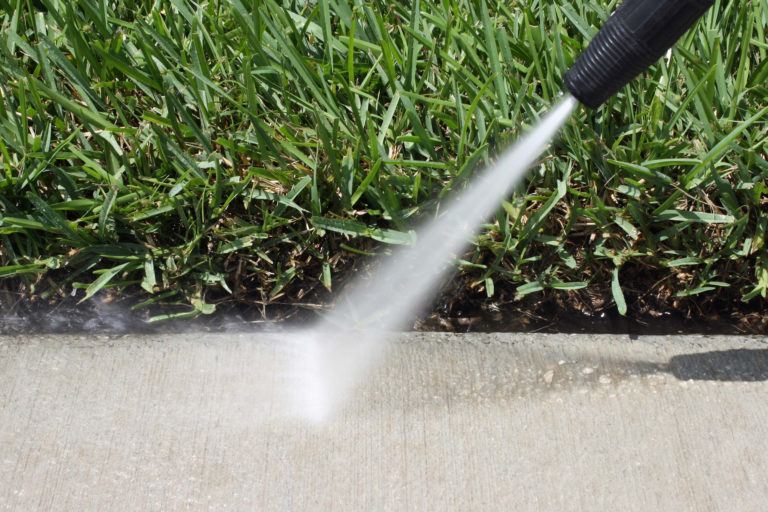
Quick Tips
Concrete is tough, but it’s not invincible. Over time, driveways, patios, and garage floors collect oil stains, mildew, dirt, and even rust, turning them into unsightly messes. Whether you want to restore your driveway’s curb appeal or prevent long-term damage, a proper cleaning routine is essential. Let’s get that concrete looking spotless.
Why Cleaning Concrete Matters
Concrete may be durable, but it’s also porous—meaning it absorbs spills, stains, and grime. If left uncleaned, stains can become permanent, mildew can create slippery surfaces, and long-term neglect can weaken the concrete’s integrity. Regular cleaning preserves its strength, improves appearance, and extends its lifespan.
What You’ll Need to Clean Concrete
Before you start, gather these cleaning supplies:
- Pressure washer or garden hose with nozzle – For rinsing and deep cleaning.
- Broom or stiff-bristled brush – Helps loosen dirt and debris.
- Degreaser or dish soap – Cuts through oil stains.
- White vinegar or baking soda – Great for natural stain removal.
- Muriatic acid (for severe stains only) – Handles tough rust or discoloration.
- Protective gloves and goggles – Essential when working with chemicals.
How to Clean Concrete in 6 Steps
1. Sweep Away Loose Debris
Before you begin deep cleaning, use a broom or leaf blower to remove dirt, leaves, and loose debris. This prevents the grime from turning into muddy streaks when you start washing. Pay extra attention to corners and cracks where dirt tends to collect.
2. Pre-Treat Stains with the Right Cleaner
Different stains require different treatments:
- Oil stains: Apply a degreaser or dish soap, scrub with a stiff brush, and let it sit for 15 minutes.
- Rust stains: Use white vinegar or lemon juice, scrub lightly, and rinse.
- Mold or mildew: Mix equal parts vinegar and water, spray the area, and let it sit for 10 minutes before scrubbing.
- General grime: Sprinkle baking soda over the surface before scrubbing.
Let the cleaner soak in before moving to the next step.
3. Scrub or Use a Pressure Washer
For light stains, scrub the concrete with a stiff-bristled brush and soapy water. If you’re dealing with years of grime, a pressure washer is your best friend. Hold the nozzle at least 12 inches from the surface and use sweeping motions to avoid damaging the concrete. If you don’t own a pressure washer, rent one from a hardware store for a professional-level clean.
4. Rinse Thoroughly
Using a garden hose or pressure washer, rinse away all cleaning solutions and loosened dirt. Start at the highest point of the area and work your way down. If stains persist, repeat the scrubbing or pressure washing process.
5. Apply a Concrete Sealer (Optional, But Recommended)
To protect against future stains and weather damage, apply a concrete sealer after cleaning. Sealers repel water, oil, and mildew while keeping the surface looking fresh for longer. Choose a penetrating sealer for driveways or a wet-look sealer for patios.
6. Maintain with Regular Cleaning
To keep your concrete in top shape:
- Sweep weekly to prevent buildup.
- Spot clean spills immediately to avoid permanent stains.
- Power wash every 6–12 months for deep cleaning.
How Professionals Deep-Clean Concrete
Sometimes, DIY cleaning isn’t enough. Professional concrete cleaning services use:
- Commercial-grade pressure washers – Removes deep-set grime.
- Industrial degreasers – Cuts through heavy oil stains.
- Acid washing – Restores discolored or heavily stained surfaces.
- Polishing and sealing – Extends the life of decorative concrete.
If your concrete still looks rough after cleaning, a professional may be the best option (concrete maintenance guide).
How Often Should You Clean Concrete?
- Light cleaning: Every 2–3 months to prevent buildup.
- Pressure washing: Every 6–12 months for deep cleaning.
- Stain removal: As soon as spills happen to avoid permanent marks.
- Sealing: Every 2–3 years for maximum protection.
Final Thoughts
Concrete surfaces take a beating, but regular cleaning keeps them looking great and lasting longer. Whether it’s your driveway, patio, or garage floor, a little maintenance goes a long way.
For more outdoor cleaning tips, check out How to Clean a Brick Patio. Keep your outdoor spaces fresh and stain-free!